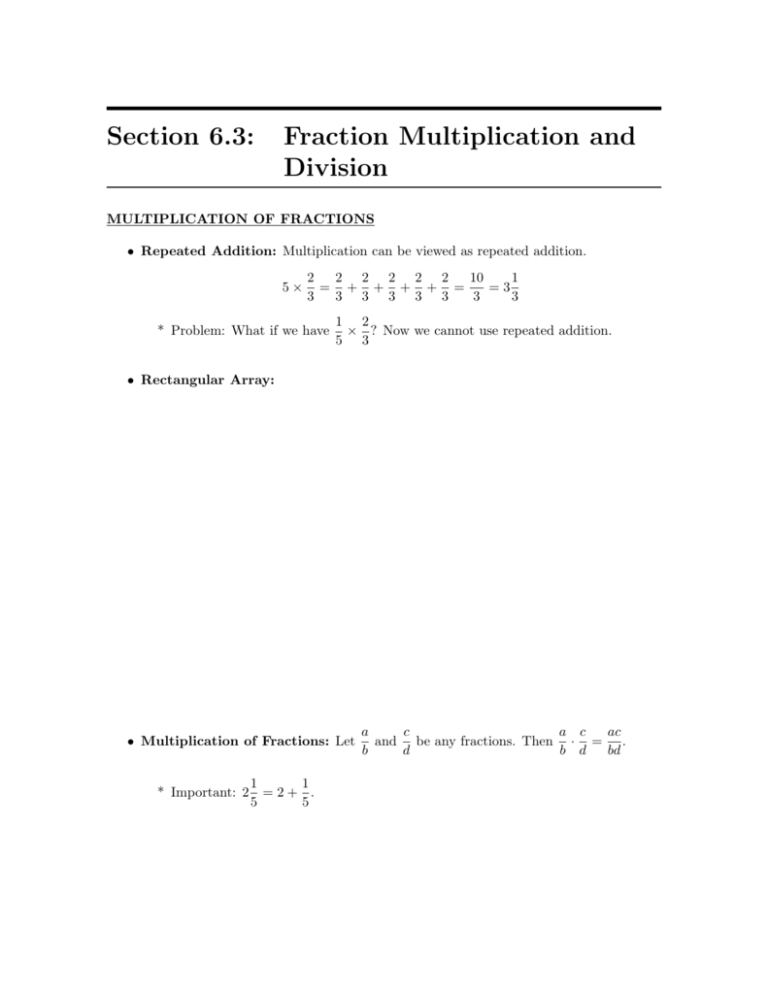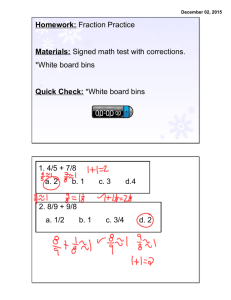Section 6.3: Fraction Multiplication and Division
advertisement

Section 6.3: Fraction Multiplication and Division MULTIPLICATION OF FRACTIONS • Repeated Addition: Multiplication can be viewed as repeated addition. 5× 2 2 2 2 2 2 10 1 = + + + + = =3 3 3 3 3 3 3 3 3 * Problem: What if we have 1 2 × ? Now we cannot use repeated addition. 5 3 • Rectangular Array: • Multiplication of Fractions: Let 1 1 * Important: 2 = 2 + . 5 5 a c a c ac and be any fractions. Then · = . b d b d bd SECTION 6.3: FRACTION MULTIPLICATION AND DIVISION 2 Example 1: Calculate the following and express as a proper fraction or mixed number in simplest form. (a) 2 15 × = 3 4 (b) 16 35 × = 5 24 1 4 (c) 8 × 3 = 4 5 (d) 3 2 4 + × = 5 3 7 SECTION 6.3: FRACTION MULTIPLICATION AND DIVISION 3 Properties of Fraction Multiplication • Closure Property: The product of two fractions is a fraction. • Commutative Property: a c c a × = × . b d d b a • Associative Property: × b c e × d f = a b × c e × d f • Multiplicative Identity Property: One is the multiplicative identity. Therefore, a a a ×1= =1× . b b b a • Multiplicative Inverse Property: For every nonzero fraction , there is an unique b b a b fraction such that × = 1. a b a * For a b a 6= 0, is called the multiplicative inverse or reciprocal of . b a b a • Distributive Property: b c e + d f = ac ae + . bd bf SECTION 6.3: FRACTION MULTIPLICATION AND DIVISION 4 Example 2: Solve for x: 2 3 x= 3 5 DIVISION OF FRACTIONS: 15 3 3 • Visual Approach: When we want to solve ÷ , we are asking how many are 16 16 16 15 there in . 16 • As a result of the missing factor approach, we have 35 ÷ 7 5 35 7 ÷ = = 16 8 16 ÷ 8 2 • Division of Fractions: Let c a c a d a and be any fractions with c 6= 0. Then ÷ = × . b d b d b c SECTION 6.3: FRACTION MULTIPLICATION AND DIVISION • Why do we invert and multiply when we divide fractions? ◦ Multiplication Approach: ◦ Missing Factor Approach: 5 SECTION 6.3: FRACTION MULTIPLICATION AND DIVISION 6 Example 3: Calculate the following and express the answer as a proper fraction or mixed number in simplest form. (a) 8 4 ÷ 11 3 (b) 33 11 ÷ 14 7 5 3 (c) 4 ÷ 3 4 8 1 5 (d) + 3 4 1 5 ÷ 4 6 Example 4: Inga was making a cake that called for 4 cups of flour. However, she could only find a two-thirds measuring cup. How many two-thirds measuring cups of flour will she need to make her cake? 7 Example 5: An auditorium contains 315 occupied seats and was filled. How many seats 9 are in the auditorium? SECTION 6.3: FRACTION MULTIPLICATION AND DIVISION 7 1 2 Example 6: Mary bought 20 yards of material to make aprons. Each apron requires 1 2 5 yards of material. (a) How many aprons can Mary make? (b) How much fabric is left over? Exact answer only. Example 7: Kids belonging to the Boys and Girls Club of America collected cans and bottles to raise money by returning them for the deposit. If 54 more cans than bottles were collected 5 of the total number of beverage containers collected, how and the number of bottles was 11 many bottles and how many cans were collected? 8 SECTION 6.3: FRACTION MULTIPLICATION AND DIVISION Example 8: Ticket sales for this season of the Performing Arts Center have been brisk. Twoninths of the people purchased 5 or more tickets, one-third purchased 4 tickets, one-fourth purchased 3 tickets, one-eighth purchase 2 tickets and 360 people purchased a single ticket. How many people have purchased tickets for this season of the Performing Arts Center? 1 1 Example 9: Upon his death, Mr. Freespender left of his estate to his wife, to each of his 2 8 1 two children, to each of his three grandchildren, and the remaining $15, 000 to his favorite 16 university. What was the value of his entire estate?







